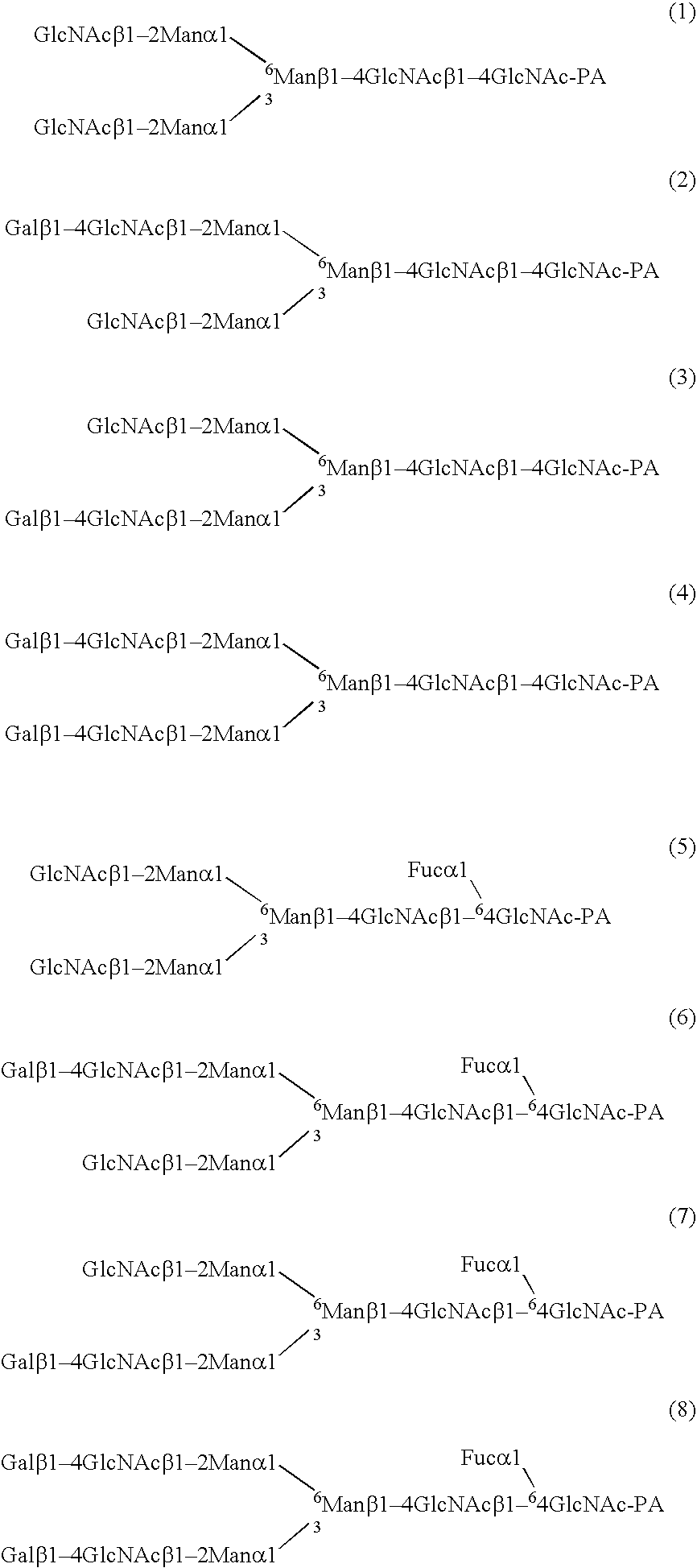Cells of which genome is modified
a technology of cells and genomes, applied in the field of cells whose genomes are modified, can solve the problems of repeated trial and error, unsuitable for antibody medicament production, and unsuitable for clones used in the production of pharmaceutical preparations
- Summary
- Abstract
- Description
- Claims
- Application Information
AI Technical Summary
Benefits of technology
Problems solved by technology
Method used
Image
Examples
example 1
Production of Cell Stably Producing Anti-CCR4 Chimeric Antibody
[0477] Cells which capable of stably producing an anti-CCR4 chimeric antibody were prepared as follows by using a tandem type expression vector pKANTEX2160 for an anti-CCR4 chimeric antibody described in WO 01 / 64754.
(1) Preparation of Antibody-Producing Cell Using Rat Myeloma YB2 / 0 Cell
[0478] After introducing 10 μg of the anti-CCR4 chimeric antibody expression vector pKANTEX2160 into 4×106 cells of rat myeloma YB2 / 0 cell (ATCC CRL 1662) by electroporation (Cytotechnology, 3, 133 (1990)], the cells were suspended in 40 ml of Hybridoma-SFM-FBS(5) [Hybridoma-SFM medium (manufactured by Invitrogen) supplemented with 5% FBS (manufactured by PAA Laboratories)] and dispensed in 200 μl / well into a 96 well culture plate (manufactured by Sumitomo Bakelite). After culturing at 37° C. for 24 hours in a 5% CO2 incubator, G418 was added to give a concentration of 1 mg / ml, followed by culturing for 1 to 2 weeks. Culture supernatan...
example 2
Comparison of Antibody Composition Produced by an Antibody-Producing Cell in Which Expression of FUT8 Gene Has Been Decreased With an Antibody Composition Produced by its Parent Cell
[0483] ADCC activities were compared between an antibody composition produced by a cell in which genome is modified so as to have a decreased activity of the α1,6-fucose modifying enzyme with an antibody composition produced by its parent cell.
(1) Preparation of Antibody Compositions
[0484] As an antibody composition produced by an antibody-producing cell in which genome is modified so as to have a decreased activity of the α(1,6-fucose modifying enzyme, an antibody composition KM2760-1 purified from culture supernatant of KM2760#58-35-16 in which the transcription product of FUT8 gene was low described in the item (1) of Example 1 was used.
[0485] An antibody composition produced by rat myeloma cell YB2 / 0 cell (ATCC CRL1662) which was a parent cell was prepared as follows.
[0486] After introducing 10...
example 3
Preparation of CHO Cell in Which FUT8 Gene is Disrupted and Production of Antibody Using the Cell
[0510] A CHO cell from which the genome region comprising the CHO cell FUT8 gene exon 1 was deleted was prepared and the ADCC activity of an antibody produced by the cell was evaluated.
1. Construction of Chinese Hamster FUT8 Gene Exon 2 Targeting Vector Plasmid pKOFUT8Puro
(1) Construction of Plasmid ploxPPuro
[0511] A plasmid ploxPPuro was constructed by the following procedure (FIG. 4).
[0512] In 35 μl of NEBuffer 4 (manufactured by New England Biolabs), 1.0 μg of a plasmid pKOSelectPuro (manufactured by Lexicon) was dissolved, and 20 units of a restriction enzyme AscI (manufactured by New England Biolabs) were added thereto, followed by digestion at 37° C. for 2 hours. After the digestion, the solution was subjected to 0.8% (w / v) agarose gel electrophoresis to purify a DNA fragment of about 1.5 Kb containing a puromycin-resistant gene expression unit.
[0513] On the other hand, 1.0...
PUM
| Property | Measurement | Unit |
|---|---|---|
| concentration | aaaaa | aaaaa |
| concentration | aaaaa | aaaaa |
| concentration | aaaaa | aaaaa |
Abstract
Description
Claims
Application Information
 Login to View More
Login to View More - R&D
- Intellectual Property
- Life Sciences
- Materials
- Tech Scout
- Unparalleled Data Quality
- Higher Quality Content
- 60% Fewer Hallucinations
Browse by: Latest US Patents, China's latest patents, Technical Efficacy Thesaurus, Application Domain, Technology Topic, Popular Technical Reports.
© 2025 PatSnap. All rights reserved.Legal|Privacy policy|Modern Slavery Act Transparency Statement|Sitemap|About US| Contact US: help@patsnap.com



